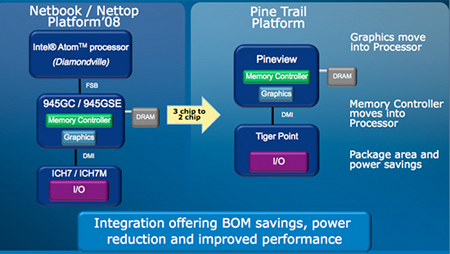Intel leaks details of “Pine Trail” Atom
May 19, 2009 — by LinuxDevices Staff — from the LinuxDevices Archive — 1 views Intel has provided a few details of its next-generation Atom platform for netbooks, code-named “Pine Trail.” The new platform shrinks the number of chips required to develop a device down to two, the CPU package called “Pineview” and the I/O controller called “Tiger Point,” reports say.
Intel has provided a few details of its next-generation Atom platform for netbooks, code-named “Pine Trail.” The new platform shrinks the number of chips required to develop a device down to two, the CPU package called “Pineview” and the I/O controller called “Tiger Point,” reports say.
Pine Trail has been rumored for some time, mostly thanks to reports by Taiwanese hardware vendors, but not officially acknowledged by Intel until today, as far as we're aware. In a conference call cited by PC Magazine, The Wall Street Journal, and other publications, Noury Al-Khaledy, Intel's general manager for netbooks and nettops, is said to have provided details of its new two-chip Atom platform.
Intel's first-ever Atom processors, the Z5xx chips that were originally code-named “Silverthorne,” already offer a two-chip solution, since they were released from the start as 14 x 13mm CPUs designed to operate with the 22 x 22mm SCH US15W (“Poulsbo”) companion chip. But, while these Z5xx CPUs have shown up in MIDs (mobile internet devices), a variety of embedded devices, and a few mini-notebooks, the majority of netbooks and nettops employ the N270 and 230, aka “Diamondville.” Architecturally identical to the Z5xx series, these are 22mm x 22mm CPUs that were designed to be more affordable, and rely on separate northbridge and southbridge chips — known collectively as the 945GSE for the N270, and 945GC for its desktop cousin.
While the N270 itself has a modest TDP of just two Watts, its 945GSE (945GCSE northbridge and 82801GBM southbridge) chipset chews up another six Watts. In contrast, Silverthorne and Poulsbo together use just 4.5 Watts, delivering improved battery life — but at a cost. While the N270 reportedly costs manufacturers around $46, the Z530/SCH US15W solution is said to run $95.
Pine Trail, with its Pineview CPU and Tiger Point I/O controller, then, seems to be an attempt to provide customers with fanless operation and lower power consumption, but at a lower price. Pine Trail will apparently use a 45nm production process throughout, unlike the Diamondville platform, which uses 45nm for the CPU but 130nm for its supporting chips.

Intel's upcoming Pine Trail chipset
Source: Intel
(Click to enlarge)
Intel's Al-Khaledy is quoted as saying that Pine Trail will bring the Atom's memory controller and graphics core on-die, as pictured above, improving performance and significantly reducing thermal output. But in a move that will disappoint some, the chipmaker apparently doesn't plan to enhance the Atom's graphics controller to make it compatible with HD video. (Nvidia has already done exactly that with its Ion platform, which gives the Atom a single northbridge/southbridge chip that includes a GeForce 9400 graphics processor.) The Ion, however, does not appear to be destined to offer Linux support anytime soon.
Quoted by PC Magazine, Al-Khaledy said the Atom has been positioned for simple tasks such as Internet access, email, and social networking, not those requiring advanced graphics. “Some customers are using an Nvidia chip, and they can go compete in the market for end users,” he is said to have continued. “I think it's one of the best problems to have: everyone innovating around the Atom processor.”
Intel representatives reportedly declined to provide additional information — pricing and speed, for example — about Pine Trail, except to say that products based on it will ship in the fourth quarter. Further details may be released at Taiwan's Computex computer exhibition next month, the company added.

Intel's Moblin 2.0
(Click to enlarge)
Comments about Pine Trail came in the context of today's announcement by Intel-backed Moblin.org of the beta release of Moblin v2 for Netbooks and Nettops. Optimized for the Intel Atom, the Linux-based mobile stack (pictured above) is touted as offering fast booting and optimized battery life, plus a new “M-zone” desktop that can be customized by different OEMs and service providers.
Availability
To read PC Magazine's report on today's Pine Trail announcements, see here.
This article was originally published on LinuxDevices.com and has been donated to the open source community by QuinStreet Inc. Please visit LinuxToday.com for up-to-date news and articles about Linux and open source.